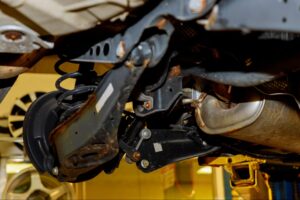
Common Signs Your Transmission is Going Out
Your car’s transmission is responsible for shifting gears and ensuring smooth acceleration, making it one of the most critical components of your vehicle. When it begins to fail, your car often gives you multiple warning signs that something’s wrong. The earlier you catch these signs, the easier (and cheaper) it is to fix the issue before major damage occurs. Below, we break down the most common symptoms of a failing transmission, explain the causes of these issues, and guide you on what to do next.
Unusual Performance While Driving
When your transmission is going out, one of the first things you’ll notice is a change in the way your car drives. These changes might be subtle at first, but typically worsen over time.
Slipping Gears
If your vehicle suddenly changes gears for no reason or won’t stay in gear, your transmission may be slipping, which can lead to a loss of power and control, especially during acceleration.
Delayed Acceleration
A lag between pressing the gas and your car speeding up is a sign that your transmission isn’t engaging correctly.
Jerking or Hesitation
If shifting gears feels rough or your car jerks during transitions, your transmission might be struggling to operate smoothly.
Strange Sounds That Indicate Trouble
Noises are among the most recognizable red flags. They often occur before any dashboard lights appear and shouldn’t be ignored.
Whining or Humming
A high-pitched whine or constant hum while driving may suggest worn gears or low transmission fluid.
Grinding When Shifting
Grinding sounds during gear changes—especially in manual vehicles—often mean worn synchronizers or clutch components.
Clunking or Banging
Loud clunks can indicate serious internal damage or loose parts inside the transmission housing.
Dashboard Warnings and Fluid Clues
Your vehicle’s built-in warning systems and fluid condition offer valuable clues about transmission health.
Check Engine Light
While vague, a check engine light often signals issues with transmission sensors or internal pressure imbalances.
Transmission Warning Light
In newer vehicles, a dedicated transmission light may illuminate when a problem is detected.
Dark or Burnt Transmission Fluid
Healthy transmission fluid is bright red and has a slightly sweet smell. If yours is dark, dirty, or smells burnt, it’s no longer providing proper lubrication.
Visible Fluid Leaks
Puddles or spots of red fluid beneath your vehicle are a clear indication of a transmission leak, typically caused by a seal, gasket, or transmission cooler line.
Unusual Smells and Heat
When your transmission is in distress, heat and odor become additional warning signs.
Burning Smell
Overheated transmission fluid often produces a sharp, burnt smell. This smell ntypically points to internal friction, low fluid levels, or poor fluid quality.
Overheating
If your car feels hot near the gear shift or smells excessively warm after driving, your transmission could overheat, especially if towing or navigating hills.
Issues With Gear Engagement
Difficulty getting into gear—or staying there—is one of the most obvious signs of a failing transmission.
Trouble Shifting Into Gear
Whether automatic or manual, hesitation or resistance when shifting can point to low fluid, a worn clutch, or damaged gear synchronizers.
Stuck in One Gear
Automatic transmissions may become stuck in a single gear (often the first or second), a condition known as “limp mode,” which is designed to protect the system from further damage.
Complete Failure to Engage
If your car won’t move after shifting into “Drive” or “Reverse,” your transmission may no longer be able to engage at all.
Vibrations and Unusual Movement
How your car physically responds to acceleration or shifting can provide direct insight into the health of its transmission.
Shaking During Gear Changes
Vibrations or shaking when accelerating or switching gears could be related to worn transmission mounts or misfiring internal parts.
Lurching or Surging
Unexpected forward or backward surges—especially when the vehicle is stopped or changing gears—are strong signs of transmission malfunction.
Causes of Transmission Failure
Understanding what leads to transmission issues can help prevent costly breakdowns.
Low or Contaminated Transmission Fluid
Without proper lubrication and cooling, transmission parts wear quickly. Skipping fluid changes or running low on fluid is a major cause of damage.
Poor Driving Habits
Towing beyond your vehicle’s limits, abrupt acceleration, and hard braking all put excess strain on your transmission.
Lack of Maintenance
Neglecting transmission fluid flushes, filter changes, or inspections can allow wear and debris to build up internally.
Overheating
Excessive heat breaks down transmission fluid and weakens internal seals, accelerating wear.
What to Do if You Suspect Transmission Trouble
Catching transmission problems early can prevent a complete breakdown and save you from costly repairs. Start by checking your transmission fluid—if it’s low, dark, or smells burnt, it needs immediate attention. Next, have a technician run a diagnostic scan and schedule a professional inspection to determine whether the issue is minor or more serious.

Is it Safe to Drive With a Failing Transmission?
In short: no. Driving with a failing transmission increases the risk of sudden loss of power, stalling, or becoming stuck in traffic. Not only is this dangerous, but continued driving also causes further internal damage. If you’re experiencing slipping, delayed engagement, or rough shifting, it’s best to park your car and call for a tow. A proper diagnosis will prevent you from turning a repairable issue into a full replacement.
Repair vs. Replace: Understanding Your Options
Transmission repairs vary from minor fixes to major rebuilds. If the damage is limited to sensors, solenoids, or gaskets, repairs may be relatively affordable. However, extensive internal wear may require a complete rebuild or a new transmission. For older vehicles, the cost of replacement might exceed the car’s value. Always weigh the severity of the damage, the age of the vehicle, and its long-term reliability when deciding between repair and replacement.
Tips to Prolong Transmission Life
Preventive care is key to avoiding transmission failure. With a few simple habits, you can protect your transmission and reduce the risk of future problems:
Regularly Change Transmission Fluid
Follow your manufacturer’s recommended service interval for fluid changes, which is usually between 30,000 and 60,000 miles for most vehicles.
Avoid Towing Beyond Limits
Exceeding towing capacity puts significant strain on the transmission, especially in hot conditions or hilly terrain.
Use the Right Type of Fluid
Always use manufacturer-recommended transmission fluid to maintain proper pressure, lubrication, and temperature control.
Allow Your Vehicle Warm-Up in Cold Weather
In cold climates, let your vehicle run for a minute or two before driving to ensure proper fluid circulation.
Don’t Ignore the Signs: Prevent Transmission Failure Before it Starts
Transmission issues rarely appear out of nowhere. Your car will typically display several warning signs—such as slipping gears, rough shifting, fluid leaks, or unusual noises—long before the transmission fails. By staying alert to these symptoms and acting promptly, you can prevent major repairs and maintain your vehicle’s long-term health. Transmission repair isn’t cheap, but catching the problem early can save you thousands and keep your car running smoothly for years to come.
Visit our Cordova Auto Service & Mufflers blog to learn more about our solutions for your vehicle today!




